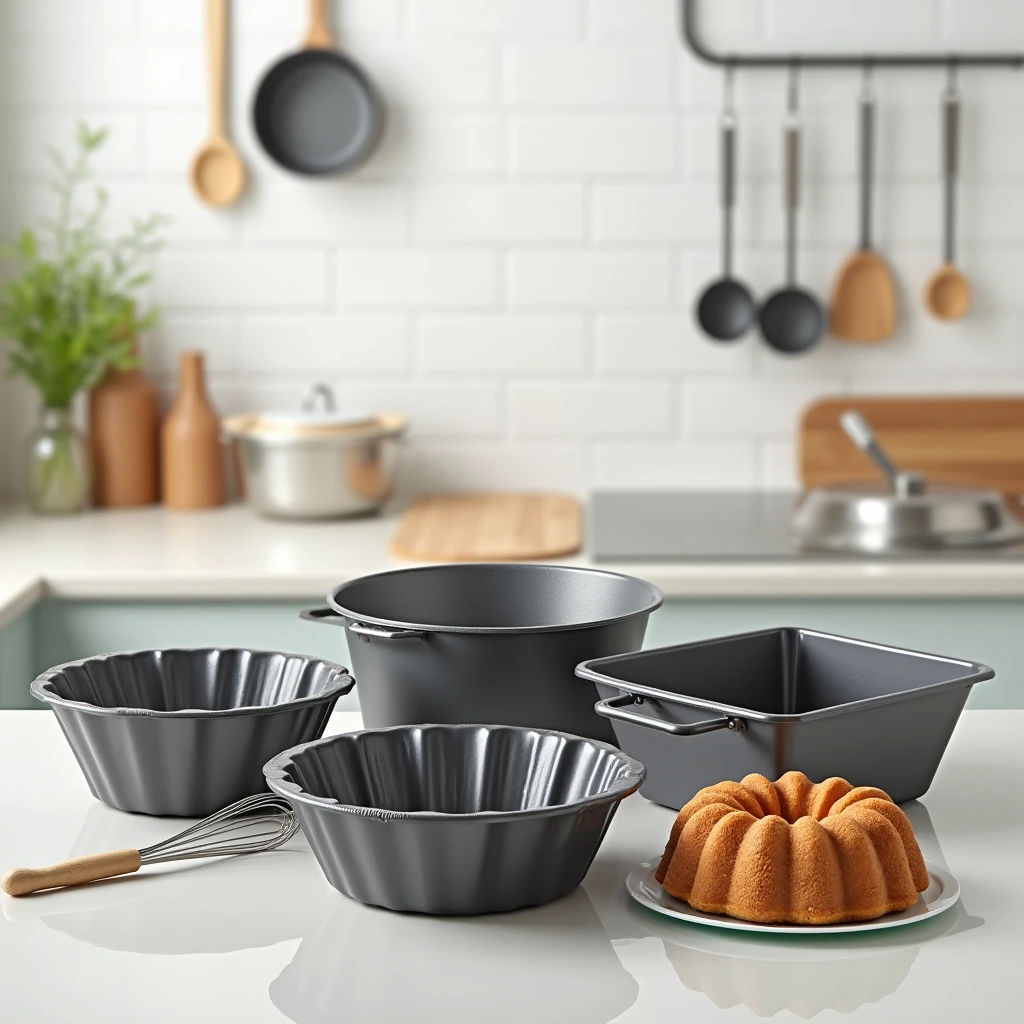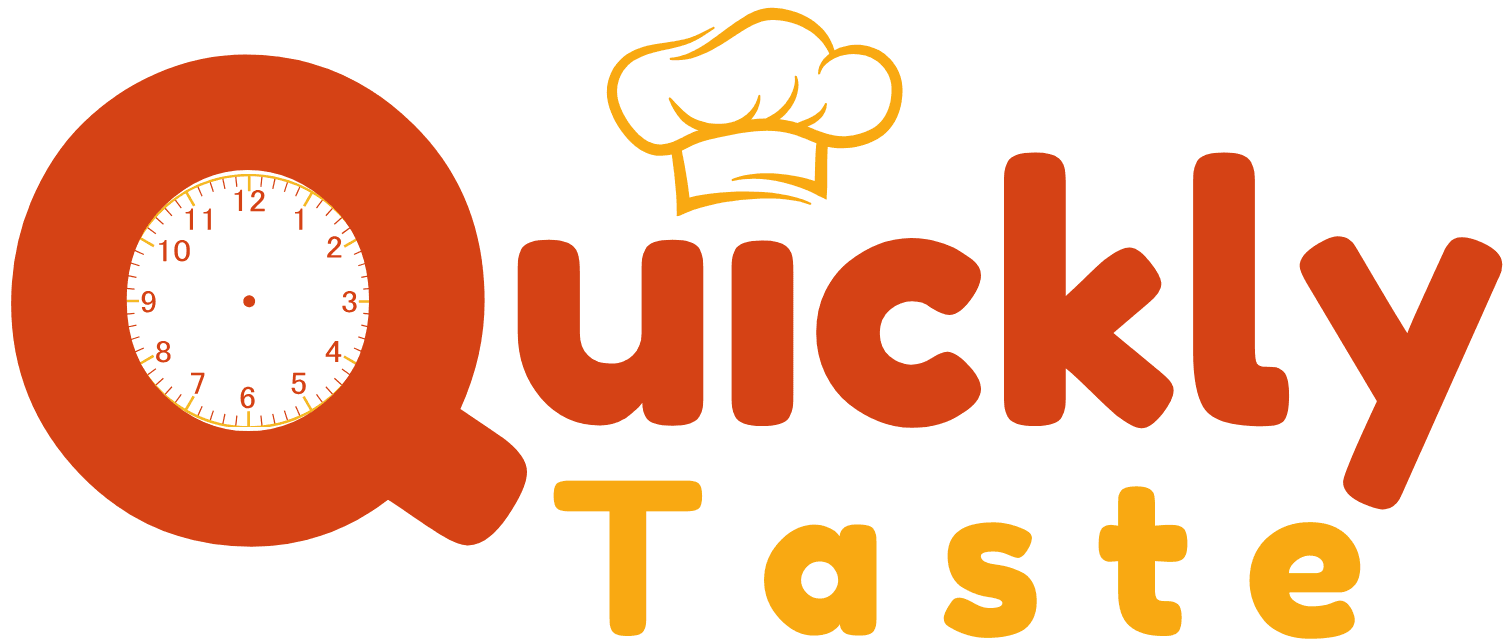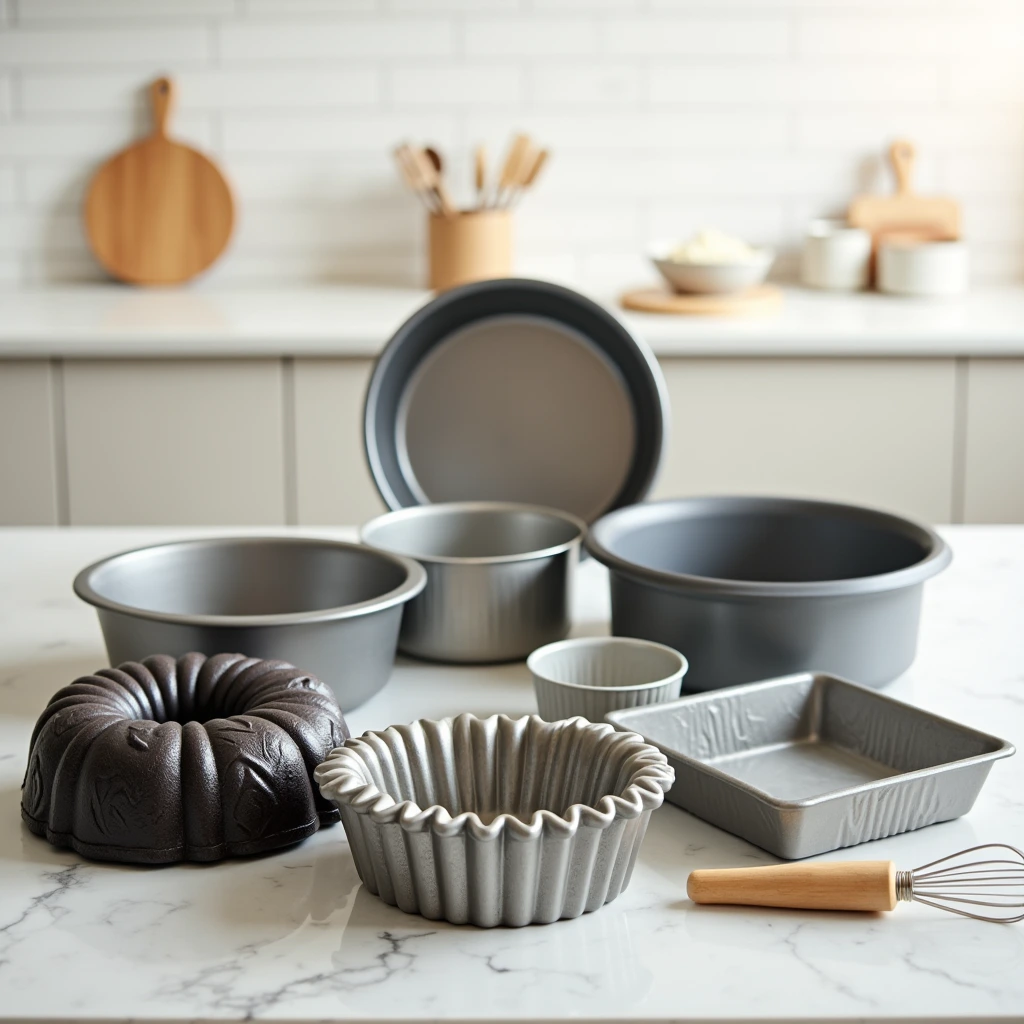Importance of Choosing the Right Cake Pan for Baking Success
Choosing the right cake pan is key to baking success. The pan you use affects heat distribution, baking time, and how easily your cake releases. Even with perfect batter, the wrong pan can cause uneven baking, sticking, or collapse.

Different pans serve different purposes. Metal pans heat quickly and evenly. Glass pans retain heat longer, which can change baking times. Non-stick pans are convenient but may require temperature adjustments. The pan’s material, size, and shape all impact the final result.
Using the right pan also improves presentation, from smooth layer cakes to detailed Bundt cakes. Whether you’re a beginner or a seasoned baker, the right pan ensures consistent, tasty, and beautiful desserts. In baking, the pan truly matters!
What is a Cake Pan?
A cake pan is a specialized baking tool designed to shape and support cake batter during baking. Typically made from materials like metal, glass, or silicone, cake pans come in various sizes and styles to suit different types of cakes. Common shapes include round, square, rectangular, and novelty designs, such as Bundt or springform pans.
The primary role of a cake pan is to evenly distribute heat to the batter, ensuring the cake bakes uniformly. Its material and design also affect how easily the baked cake can be removed without damage. For example, non-stick pans make removal easier, while springform pans are ideal for delicate cakes like cheesecakes that require minimal handling.
Cake pans are more than just containers; they play a crucial role in the texture, structure, and appearance of the finished product. Using the right pan ensures the cake rises properly, retains its shape, and looks appealing when served. In short, the cake pan is an essential tool that directly influences baking success.
Types of Cake Pans
Round Cake Pans
Round cake pans are a staple in baking and are ideal for layer cakes. They are available in various diameters and depths, ensuring even baking and consistent results. Additionally, they’re perfect for traditional cakes like sponge or chocolate layer cakes.
Square Cake Pans
Square pans are great for cakes that need clean, sharp edges. They are commonly used for brownies, sheet cakes, or layered desserts. Furthermore, their uniform shape makes cutting and decorating much easier.
Rectangular Cake Pans
These pans are incredibly versatile, often used for sheet cakes, bars, or layered desserts. Moreover, their larger surface area makes them ideal for serving a crowd and decorating with intricate designs.
Bundt Pans
Bundt pans have a decorative design with a hollow center, creating visually stunning cakes. They’re especially suited for dense cakes like pound or coffee cakes, as the unique shape promotes even baking.
Springform Pans
These pans feature a removable bottom and latch, which makes them ideal for delicate cakes like cheesecakes or tarts. Consequently, they allow for easy removal without damaging the cake.
Specialty Pans
Specialty pans, such as heart-shaped or novelty designs, add creativity to your cakes. Therefore, they’re perfect for themed occasions, ensuring your cakes are as unique as the event.
Materials Used in Cake Pans
Aluminum
Aluminum is a popular material for cake pans due to its excellent heat conductivity. It ensures even baking and prevents hotspots, making it ideal for all types of cakes. However, it is prone to scratching and may react with acidic ingredients.
Stainless Steel
Stainless steel pans are durable, rust-resistant, and non-reactive, making them suitable for various recipes. However, they do not conduct heat as efficiently as aluminum, which may result in longer or uneven baking times without proper monitoring.
Silicone
Silicone cake pans are flexible, non-stick, and easy to store. They are perfect for intricate shapes and designs because they release cakes easily. However, they may not provide the same crisp edges or even heat distribution as metal pans.
Glass
Glass pans retain heat well and are best for cakes that require a gradual baking process. They allow you to monitor the baking progress visually. However, they heat unevenly and can cause overbrowning if not used carefully.
Ceramic
Ceramic pans are ideal for their aesthetic appeal and even heat distribution. They are perfect for slow baking and serving directly from the pan. However, they are heavier and less versatile compared to other materials.
How to Choose the Right Cake Pan
Size Considerations
The size of your cake pan should match your recipe to ensure proper baking. A pan that is too small can cause overflow, while one that is too large may lead to a flat or uneven cake. Always check the recipe’s recommendations for pan size and capacity.
Shape and Design
The shape and design of the pan impact the cake’s appearance and suitability for different occasions. Round and square pans are versatile for most cakes, while Bundt or specialty pans add decorative touches. Choose a shape that complements your intended presentation.
Material Preferences
Different materials affect baking performance. Aluminum provides even heat distribution, while stainless steel offers durability. Silicone is great for intricate designs, and glass allows you to monitor the cake as it bakes. Consider the material based on your baking style and cake type.
Non-Stick vs. Traditional Pans
Non-stick pans make cake removal easier and reduce the need for excessive greasing. However, traditional pans, such as aluminum or stainless steel, often offer better browning and are more durable. Decide based on your need for convenience versus performance.
How to Use a Cake Pan Properly
Greasing and Preparing the Pan
Properly greasing your cake pan ensures the cake releases easily. Use butter, oil, or non-stick spray, and add a light dusting of flour for extra assurance. For delicate cakes, consider lining the pan with parchment paper.
Filling with Batter
When filling the pan, pour the batter evenly to ensure uniform baking. Use a spatula to smooth the surface, preventing uneven tops. Follow the recipe’s guidance to avoid incorrect proportions, which can impact the texture.
Avoiding Overfilling or Spillage
To prevent overflow, fill the pan no more than two-thirds full. Overfilling can lead to batter spilling during baking, causing uneven cooking or a messy oven. If you have excess batter, bake a second smaller cake or cupcakes.
Tips for Easy Cake Release
Allow the cake to cool for 10–15 minutes after baking before attempting to release it. Run a knife along the edges to loosen it gently. For non-stick or springform pans, release the latch or turn the cake out carefully onto a cooling rack. Proper preparation and cooling ensure the cake comes out flawlessly.
Maintaining and Cleaning Your Cake Pan
Hand Washing vs. Dishwasher
Hand washing is the best way to clean cake pans, especially non-stick or specialty pans. Use warm, soapy water and a soft sponge to avoid scratching the surface. While some pans are dishwasher-safe, repeated exposure to high heat and detergents may damage non-stick coatings or discolor metal pans.
Removing Stubborn Stains
For stubborn stains or baked-on residue, soak the pan in warm, soapy water for 15–30 minutes. Use a non-abrasive scrubber or a baking soda paste to gently remove tough spots. Avoid harsh chemicals or steel wool, as they can damage the pan’s finish.
Storing Your Pans Safely
Store cake pans in a cool, dry place to prevent rust or warping. Stack pans of similar sizes to save space, and place parchment paper or cloth between them to avoid scratches. For specialty pans with intricate designs, store them separately or in protective covers to maintain their shape. Proper care ensures your pans stay in excellent condition for years to come.
Common Mistakes When Using Cake Pans
Wrong Pan Size
Using the wrong pan size is a frequent mistake that affects the cake’s outcome. A pan that’s too small can cause overflow and uneven baking, while one that’s too large may result in a thin, dry cake. Always check your recipe’s size recommendation and measure your pans if unsure.
Over or Under Greasing
Greasing the pan incorrectly can lead to baking disasters. Over-greasing may cause the edges of your cake to become too crisp or greasy, while under-greasing results in sticking, making it difficult to release the cake. Follow proper greasing methods, and consider parchment paper for delicate cakes.
Ignoring Pan Material Guidelines
Different pan materials require specific handling. For instance, dark pans absorb more heat and may require lower temperatures, while glass pans take longer to heat up and retain heat after baking. Ignoring these differences can lead to uneven baking or overcooked edges. Always consider the material when adjusting baking times and temperatures.
Cake Pans for Different Occasions
Wedding Cakes
Wedding cakes require round or square pans in multiple sizes to create tiered layers. Sturdy pans with straight edges are ideal for clean, professional-looking cakes. For intricate designs, consider using specialty pans or molds to add decorative elements.
Birthday Cakes
For birthdays, round and rectangular pans are popular choices for classic layer or sheet cakes. However, specialty pans in shapes like hearts, stars, or numbers can make the celebration extra special. Non-stick pans are great for hassle-free cake release and easy decorating.
Holiday Baking
Holiday baking often calls for festive and creative designs. Bundt pans are perfect for holiday cakes with intricate patterns, while novelty pans in seasonal shapes, such as trees or snowflakes, add a fun touch. Silicone pans are also great for themed cakes due to their flexibility and ease of use.
Top Cake Pan Brands to Consider
Wilton
Wilton is a trusted name in baking, known for its wide variety of cake pans. From standard round and square pans to specialty and novelty designs, Wilton offers durable, affordable options suitable for both beginners and professionals. Their non-stick coatings and reliable performance make them a go-to choice.
Nordic Ware
Famous for its iconic Bundt pans, Nordic Ware is a premium brand offering high-quality aluminum pans. Known for even heat distribution and intricate designs, their pans create stunning cakes that release effortlessly. They are perfect for those seeking both functionality and aesthetic appeal.
USA Pan
USA Pan is celebrated for its commercial-grade bakeware made from aluminized steel. Their pans feature a patented non-stick coating and are designed for durability and even baking. These pans are ideal for serious bakers looking for professional-quality results.
Fat Daddio’s
Fat Daddio’s specializes in anodized aluminum pans, which provide even heat distribution and quick cooling. Their pans are free from coatings, making them safe for high-temperature baking. Loved by professionals, they are great for consistent and reliable results, especially for tiered and specialty cakes.
FAQs
What pan is best for baking cake?
The best pan for baking a cake depends on the recipe and desired outcome. For general use, aluminum pans are ideal due to their even heat distribution. For intricate designs, a non-stick or silicone pan works best. Round pans are great for layer cakes, while rectangular pans suit sheet cakes.
Is a cake pan 9×13?
Yes, a 9×13 pan is a common rectangular cake pan size, often used for sheet cakes, bars, and desserts. It provides a large surface area, making it ideal for serving a crowd or decorating with elaborate designs.
Is an 8-inch or 9-inch cake pan better?
Both sizes are common, but the choice depends on your recipe. An 8-inch pan produces a taller cake due to its smaller diameter, while a 9-inch pan creates a slightly shorter, wider cake. Always follow your recipe’s recommendation to ensure proper baking.
What is the most common cake pan size?
The most common cake pan size is an 8- or 9-inch round pan, frequently used for layer cakes. Rectangular 9×13 pans and square 8×8 or 9×9 pans are also widely used for sheet cakes and brownies.
Recommended Resources for Choosing the Perfect Cake Pan
If you’re looking for more detailed guidance on selecting the best cake pan for your needs, there are numerous online resources to explore. Websites like Wilton and Nordic Ware provide insights into their product lines and offer expert tips for using their pans effectively. For those interested in professional-grade bakeware, USA Pan and Fat Daddio’s offer comprehensive guides and tutorials on choosing and caring for their pans. Additionally, The Spruce Eats has a range of articles on cake pan comparisons, along with baking tips for home bakers. For specialty baking tools and reviews, Serious Eats and King Arthur Baking are trusted sources for exploring innovative designs and techniques.
If you’re new to baking or want to improve your skills, video tutorials on platforms like YouTube (check out channels like Preppy Kitchen or Sally’s Baking Addiction) are invaluable. These resources not only demonstrate how to use various pans but also highlight how pan selection impacts baking outcomes. By leveraging these external links, you can enhance your knowledge and confidence, ensuring every cake you bake is a success.
You can discover more recipes on our website:
- Homemade Carrot Juice Recipe
- Pumpkin Pie Recipe Condensed Milk
- Easy McCormick French Toast
- Lemon Tiramisu Recipe
- Jif Peanut Butter Cookie Recipe
- Brisket Chili Recipe
Conclusion
Choosing the right cake pan is essential for successful baking. The pan you select directly impacts the cake’s texture, structure, and appearance. From size and shape to material and coating, each factor plays a significant role in achieving the desired results. Using an appropriately sized pan ensures even baking, while selecting the correct material can enhance heat distribution and cake release.
Additionally, matching the pan type to the occasion, whether it’s for a wedding, birthday, or holiday, allows you to create visually appealing and perfectly baked cakes. Proper care and maintenance of your pans further extend their lifespan and guarantee consistent performance.
In essence, a well-chosen cake pan is more than a baking tool—it’s a key ingredient for creating beautiful, delicious, and memorable desserts. By understanding your baking needs and making informed choices, you set the foundation for success in every bake.

